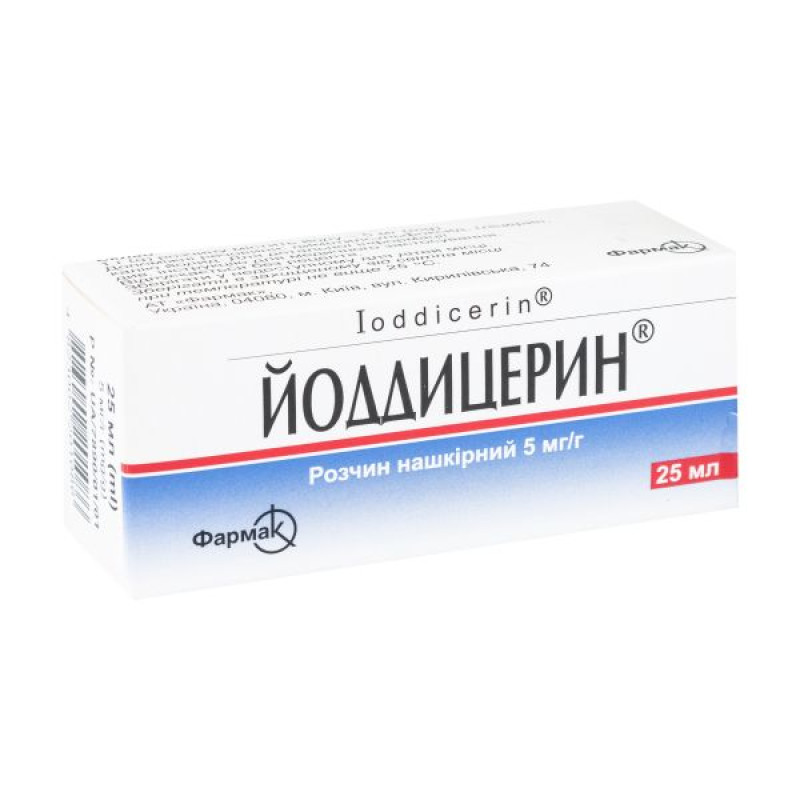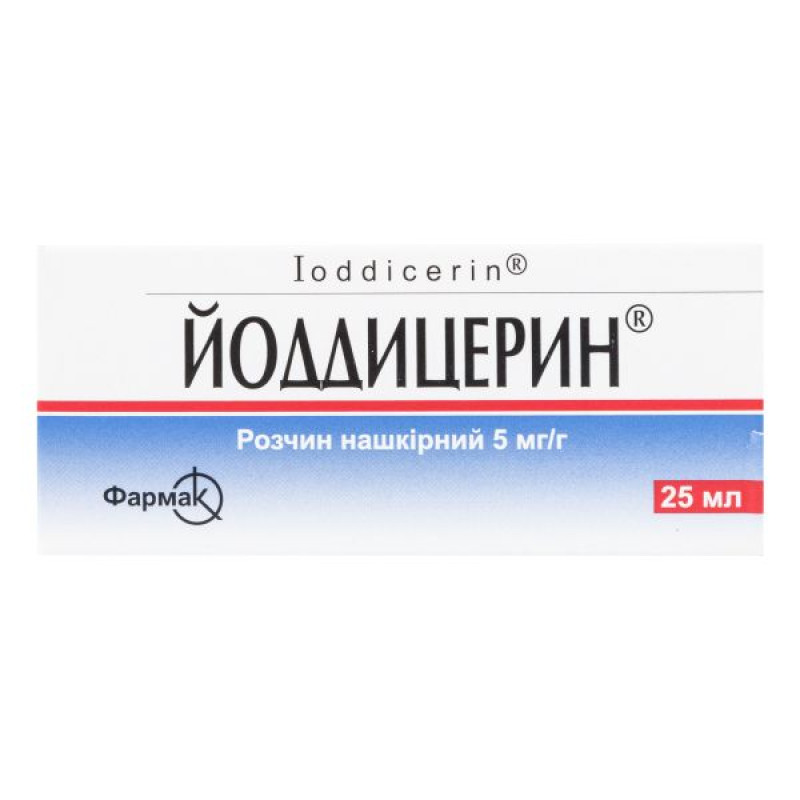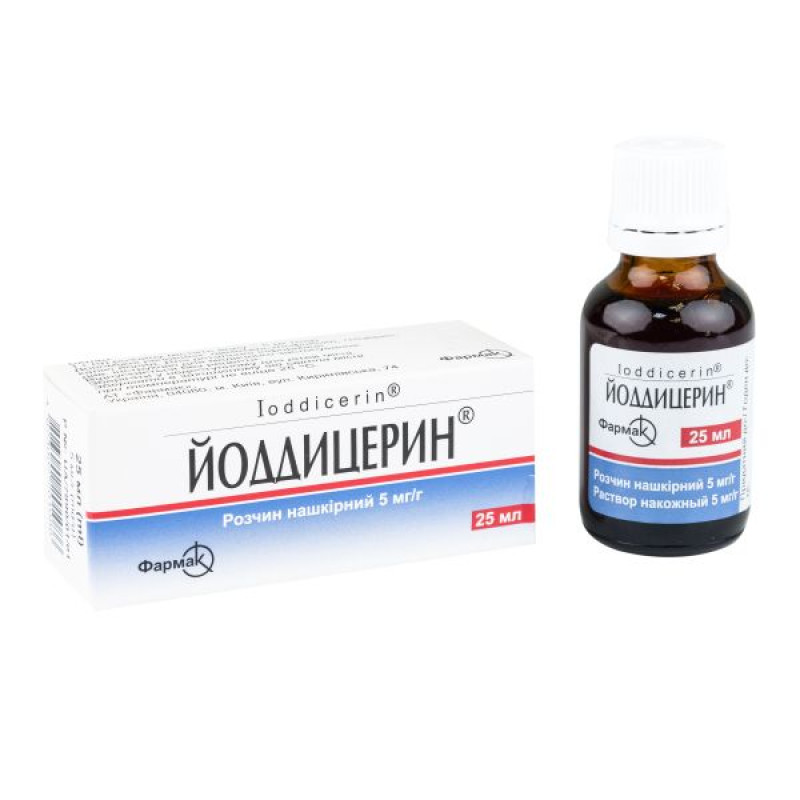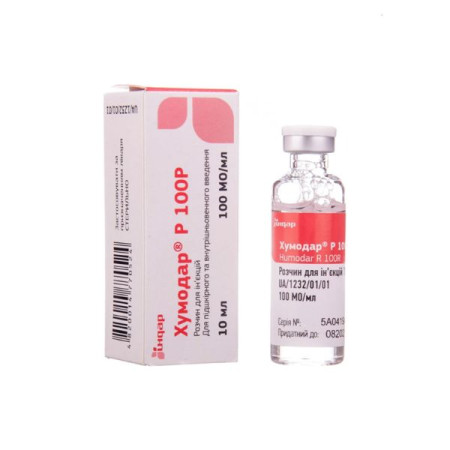Yoddicerin transdermal solution bottle 25 ml No. 1

Instructions for Yodditserin transdermal solution, bottle 25 ml No. 1
Composition
active ingredient: iodine;
1 g of solution contains 5 mg of iodine;
excipients: dimethyl sulfoxide, glycerin, potassium iodide.
Dosage form
The solution is topical.
Main physicochemical properties: transparent viscous liquid of brown-orange color with a specific odor.
Pharmacotherapeutic group
Antiseptics and disinfectants. ATX code D08A G03.
Pharmacological properties
Pharmacodynamics.
A broad-spectrum antibacterial agent that has bactericidal, anti-inflammatory, and local analgesic effects. Antimicrobial and antiviral activity is associated with the same mechanism of action on surface polysaccharides, lipids, and proteins of cell wall biopolymers of pathogens of various infections.
The bactericidal effect of Yodditserin® extends to staphylococci, streptococci, meningococci, gonococci, pneumococci, Escherichia, including enteropathogenic, invasive and toxigenic strains, salmonella, Klebsiella, Proteus, serrations, citrobacteria, Haemophilus influenzae, pseudomonads, fusobacteria, clostridia, non-clostridial anaerobes, peptococci, mycoplasmas, chlamydia, herpes viruses, and chickenpox.
The drug is inactive against microorganisms that have wax and fat in their walls (mycobacteria of tuberculosis, leprosy, all corynebacteria, nocardia), the surface of which is hydrophobic and is not wetted by Yoddicerin®.
Unlike other iodine preparations intended for topical use, it does not concentrate and does not accumulate in the area of action, which eliminates painful, irritating and necrotizing effects. Due to the presence of dimexide in the preparation, the iodine cation easily penetrates through biomembranes without damaging the membrane structures. In addition, dimethyl sulfoxide (dimexide) is able to ionize iodine molecules, which have a strong bactericidal effect on microorganisms directly in the tissues of the focus of purulent inflammation.
Pharmacokinetics.
Yoddicerin® is rapidly absorbed from the site of application and penetrates into the tissues of intact skin and mucous membranes to a depth determined by the dose of the drug and the time of its contact with the surface. There is no cumulation effect. With a single application and an average degree of pus accumulation, the effect persists for 8-12 hours. Most of the iodine is excreted by the kidneys.
Indication
In surgery - for the treatment of purulent wounds, burns, frostbite, purulent processes in soft tissues, gangrene, pleurisy, peritonitis; in obstetrics and gynecology - for the prevention of complications after abortion, for the treatment of inflammatory processes, erosions, mastitis; in dermatology and venereology - for microbial and viral dermatitis, pyoderma, herpes of the lips and skin, trichomoniasis, gonorrhea; in proctology - for paraproctitis in the infiltration stage, in otorhinolaryngology - for the treatment of otitis, sinusitis, sinusitis; in dentistry - for stomatitis, gingivitis, periodontitis. Effective in the treatment of bacterial carriage in the upper respiratory tract.
Contraindication
Hypersensitivity to iodine and any of the components of the drug, hyperthyroidism, thyroid adenoma, dermatitis herpetiformis of Duhring, the period before and after radioactive iodine therapy, simultaneous use with radioactive iodine, hepatic and renal failure, myocardial infarction, angina pectoris, severe atherosclerosis, glaucoma, cataracts, stroke, coma.
Interaction with other medicinal products and other types of interactions
Enhances the penetration through the skin of drugs that are soluble in dimethyl sulfoxide (some nonsteroidal anti-inflammatory drugs, antibiotics, etc.), which leads to an increase in their specific activity, and in some combinations to an increase in toxicity. Pharmaceutically incompatible with essential oils, ammonia solutions, white precipitated mercury (an explosive mixture is formed).
When used together with yellow mercury ointment, the formation of mercury iodide, which has a cauterizing effect, is possible.
Weakens the hypothyroid and stromogenic effects of lithium preparations.
Yoddicerin® is incompatible with other disinfectants and antiseptics, especially those containing alkalis, enzymes and mercury. In an acidic environment, the activity of the drug decreases. When used simultaneously with enzyme preparations, the latter become ineffective. Yoddicerin® is incompatible with hydrogen peroxide, preparations containing silver. In the case of patients using lithium preparations, regular use of Yoddicerin® should be avoided, especially on large surfaces, since in this case iodine can cause hypofunction of the thyroid gland. Yoddicerin® is incompatible with regenerating substances, alkaloid salts and cationic antiseptics. Dimethyl sulfoxide enhances the effect of ethanol, insulin, digitalis preparations, butadione, antibiotics, quinidine, nitroglycerin, sensitizes the body to anesthetics.
Application features
It is prescribed with caution in combination with other drugs applied to the purulent-inflammatory focus: their toxicity may increase.
It is prescribed with caution to elderly patients.
In case of long-term use of the drug, it is necessary to periodically monitor thyroid function.
Avoid contact with eyes, do not use internally.
Use during pregnancy or breastfeeding
The use of the drug during pregnancy and breastfeeding is contraindicated. If necessary, breastfeeding should be discontinued.
Ability to influence reaction speed when driving vehicles or other mechanisms
The drug Yodditserin® does not affect the reaction speed when driving or working with other mechanisms.
Method of administration and doses
Externally, in the form of applications (compresses, bandages) on the entire area of the purulent-inflammatory focus, 5-15 ml of Yodditserin® is applied 2-3 times a day for 20-30 minutes, depending on the size of the purulent focus.
The duration of treatment is determined by the time of complete cleansing of the wound surface, the appearance of granulations and epithelialization. Usually the course of treatment is from 3 to 5 days.
For large or deep lesions, turundas, tampons or gauze bandages are impregnated with Yodditserin®, applied to purulent wounds or injected into wounds, bandaged or secured with adhesive plaster. If necessary, tampons or gauze bandages impregnated with the drug are covered with polyethylene film on top to enhance the antibacterial effect.
After removing pus and washing with sterile saline or hydrogen peroxide (depending on the size of the lesion), 5-10 ml of Ioddicerin® solution is injected into serous cavities and abscess cavities and drained for constant outflow of contents. The procedure is repeated 2-3 times a day until the wound surface is completely cleansed, granulations appear and epithelialization occurs.
Children: Do not use the drug in children under 1 year of age.
Overdose
In case of overdose, symptoms of iodism (metallic taste in the mouth, runny nose, urticaria, lacrimation, drooling), burns, skin irritation are possible. Therapy is symptomatic.
In case of accidental ingestion of large amounts (50-100 ml) of Yodditserin®, vomiting, diarrhea and symptoms of intoxication develop. In these cases, the stomach is washed with a 0.5% solution of sodium thiosulfate. In severe cases, up to 5-10 ml of a 30% solution of sodium thiosulfate is administered intravenously.
Side effects
Immune system disorders: hypersensitivity reactions.
Skin and subcutaneous tissue disorders: pruritus, rash, erythema, angioedema, dermatitis, urticaria, dry skin.
General disorders and administration site conditions: hyperthermia, adynamia, local reactions including pain at the application site, burning, redness at the application site.
Gastrointestinal disorders: nausea, vomiting, diarrhea.
Injuries, poisoning and procedural complications: with prolonged use (more than 7-10 days), symptoms of iodism are possible (runny nose, urticaria-like skin rashes, drooling, metallic taste in the mouth, tearing).
Blood and lymphatic system disorders: neutropenia (due to systemic reabsorption of iodine when applied to large areas of wound surface and mucous membranes).
Endocrine disorders: hypothyroidism, hyperthyroidism (due to systemic reabsorption of iodine when applied to large areas of wound surface and mucous membranes).
Investigations: changes in thyroid function tests; changes in blood osmolarity.
Metabolism and nutrition disorders: metabolic acidosis, electrolyte disturbances (hypernatremia).
Renal and urinary disorders: renal dysfunction, acute renal failure.
Nervous system disorders: dizziness.
Mental disorders: insomnia.
Respiratory, thoracic and mediastinal disorders: bronchospasm.
Expiration date
3 years.
Do not use the drug after the expiration date indicated on the package.
Storage conditions
Store in a place protected from light at a temperature not exceeding 25 ºС.
Keep out of reach of children.
Packaging
25 ml in a bottle. 1 bottle in a pack.
Vacation category
Without a prescription.
Producer
JSC "Farmak".
Address
Ukraine, 04080, Kyiv, Kyrylivska St., 74.
There are no reviews for this product.
There are no reviews for this product, be the first to leave your review.
No questions about this product, be the first and ask your question.










